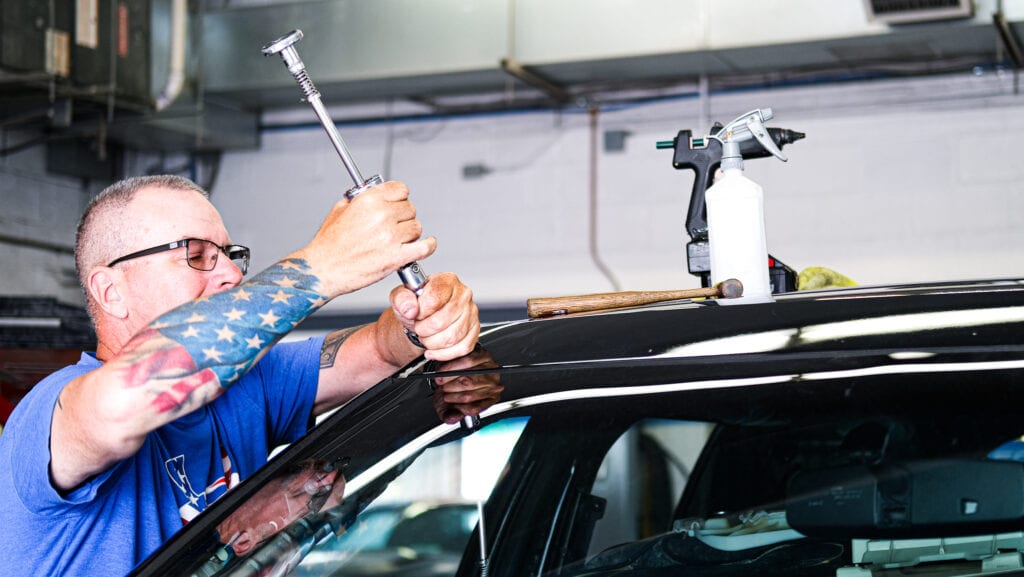Understanding Paintless Dent Repair: When It Works and When It Doesn’t

Paintless dent repair (PDR) has become one of the most sought-after methods for restoring vehicles after minor dings, dents, and hail damage. Unlike traditional auto dent repair techniques that involve sanding, filling, and repainting, PDR allows technicians to massage the dented metal back into its original form without affecting the vehicle’s factory finish. This method can be faster, more cost-effective, and environmentally friendly compared to collision dent repair that relies on paints and fillers. But PDR is not a one-size-fits-all solution. Understanding when it works—and when it doesn’t—is critical for vehicle owners deciding between PDR vs traditional dent repair.
What Is Paintless Dent Repair?
Paintless dent repair is a technique developed decades ago but has grown in popularity with modern tools and training. It involves specialized rods and tools that apply controlled pressure to the back of a dent, slowly working the metal back into shape. For dents that cannot be accessed from behind, technicians may use glue-pulling methods to gently lift the damaged area from the exterior surface.
The biggest advantage of PDR is that it keeps your car’s factory paint intact. Since no sanding or repainting is required, the original finish remains untouched, which is a big benefit for preserving a car’s value. This is especially important for high-end vehicles or those with custom finishes where paint matching can be expensive and difficult.
Advantages of Paintless Dent Repair
PDR has grown rapidly because it solves many problems car owners face after minor damage. Here are the main benefits:
- Cost-Effectiveness: Paintless dent repair often costs significantly less than traditional auto dent repair since it skips body fillers, sanding, and repainting.
- Time Savings: Many dents can be repaired in just a few hours rather than days in a body shop.
- Eco-Friendly: Since no paint or harsh chemicals are required, PDR is a greener option for collision dent repair.
- Maintains Resale Value: Keeping the original factory finish intact means the car retains more value compared to repainted panels.
- Durability: A successful PDR job leaves no signs of repair and restores the strength of the panel.
When Paintless Dent Repair Works Best
Not all dents are created equal. Some damage is perfectly suited for PDR, while other situations require traditional methods. PDR works best for:
- Small to medium-sized dents where the paint has not been cracked or chipped.
- Hail damage or parking lot dings that do not involve sharp creases.
- Shallow dents where the metal has not been overstretched.
- Panels that allow tool access behind the dent.
For these situations, PDR can deliver flawless results that look as if the dent never happened.
When Paintless Dent Repair Doesn’t Work
Despite its advantages, PDR has limitations. It is not suitable for every kind of collision dent repair. Cases where PDR may not work include:
- Severe Damage: If the metal is deeply creased or torn, PDR is not an option.
- Damaged Paint: If the impact has chipped or cracked the paint, traditional repair will be required to protect against rust.
- Aluminum Panels: While possible, aluminum is harder to manipulate, making PDR more challenging and sometimes impossible.
- Edge Dents: Dents on the edge of panels often cannot be reached with PDR tools.
- Large Dents: Dents larger than a few inches may overstretch the metal, preventing full restoration with PDR.
In these cases, traditional auto dent repair involving sanding, fillers, and repainting becomes necessary.
Comparing Paintless Dent Repair vs Traditional Dent Repair
When comparing PDR vs traditional dent repair, the choice depends on the extent of the damage and your priorities as a car owner. Traditional methods can handle severe collision dent repair, restore cracked paint, and reshape panels that PDR cannot fix. However, they are more time-consuming and costly.
PDR, on the other hand, is the best choice when dents are minor and the paint is intact. It allows for faster turnaround times and lower costs, making it especially popular among car dealerships, leaseholders, and everyday drivers looking to save money without compromising quality.
How Paintless Dent Repair Is Done
The process of PDR is meticulous and requires skill. Here’s an overview:
- Assessment: A technician inspects the damage and determines if PDR is possible.
- Access: The technician gains access behind the panel, sometimes removing trim or interior pieces.
- Tool Work: Specialized rods apply controlled pressure to the dent from behind, gradually working it back into shape.
- Glue Pulling: If access is not possible, glue tabs may be used on the exterior to pull the dent outward.
- Finishing: The technician polishes the area to ensure the surface looks as good as new.
This process requires patience, precision, and training—qualities that separate professional auto dent repair from DIY attempts.
Common Myths About Paintless Dent Repair
There are several misconceptions surrounding PDR:
- “PDR Can Fix Any Dent.” In reality, severe or paint-damaged dents still require traditional repair.
- “DIY PDR Kits Work Just as Well.” While inexpensive kits are available, professional results require training and experience.
- “It Weakens the Car’s Metal.” PDR does not compromise structural integrity when done correctly.
- “It’s Just for Small Cars.” PDR works on all vehicles, from compact cars to trucks and SUVs.
By dispelling these myths, car owners can make more informed decisions about their auto dent repair options.
The Role of Paintless Dent Repair in Collision Dent Repair
While PDR is not suitable for every accident, it plays an important role in modern collision dent repair. Many body shops now offer both PDR and traditional dent repair, allowing technicians to choose the best approach based on the type of damage. This hybrid approach ensures customers receive the most effective and cost-efficient solution for their specific situation.
Choosing the Right Shop for PDR
Not every auto body shop specializes in PDR. When choosing a provider, look for:
- Certified technicians with extensive PDR experience.
- Positive customer reviews highlighting dent repair work.
- Shops that offer both PDR and traditional repair to ensure you get the best option.
A skilled technician can make the difference between a flawless finish and a repair that still shows signs of damage.
Making the Right Choice for Your Vehicle
Paintless dent repair is an incredible advancement in auto dent repair technology. It offers a fast, cost-effective, and environmentally friendly way to fix many dents without compromising the original factory paint. However, it’s important to recognize its limitations. For deep creases, chipped paint, or extensive collision dent repair, traditional methods are still necessary.
By understanding the strengths and weaknesses of PDR vs traditional dent repair, vehicle owners can make the right choice to restore their car’s appearance, protect its resale value, and ensure long-lasting results.
Ready to Restore Your Vehicle?
If your car has dents, dings, or hail damage, our experienced team can help. We specialize in both paintless dent repair and traditional collision dent repair, ensuring your vehicle receives the right care for its specific needs. Our certified technicians take pride in delivering flawless results that protect your investment and get you back on the road quickly. For more information about our paintless dent repair services click here.
Don’t wait—schedule your repair today with Conestoga Collision.
